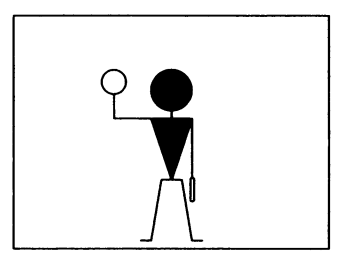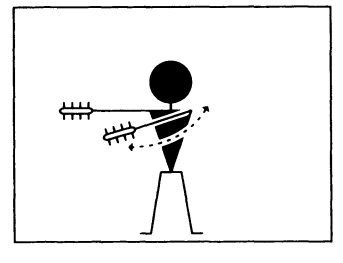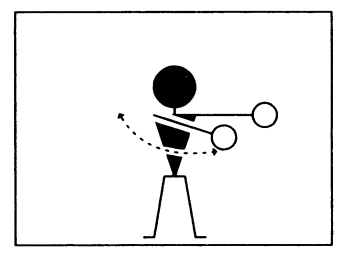(a)Right or left arm down, the other arm moved across body and extended to indicate position of the other marshaller.
| Proceed under guidance of another marshaller | | |
(b)Arms repeatedly moved upward and backward, beckoning onward.
| Move ahead. | | |
(c)Right arm down, left arm repeatedly moved upward and backward. The speed of arm movement indicates the rate of turn.
| Open up starboard engine or turn to port. | | |
(d)Left arm down, the right arm repeatedly moved upward and backward. The speed of arm movement indicates the rate of turn.
| Open up port engine or turn to starboard. | | |
(e)Arms repeatedly crossed above the head. The speed of arm movement indicates the urgency of the stop.
| Stop. | | |
(f)A circular notion of the right hand at head level, with the left arm pointing to the appropriate engine.
| Start engines. | | |
(g)Arms extended, the palms facing inwards, then swung from the extended position inwards.
| Chocks inserted. | | |
(h)Arms down, the palms facing outwards, then swung outwards.
| Chocks away. | | |
(j)Either arm and hand placed level with the chest, then moved laterally with the palm downwards.
| Cut engines. | | |
(k)Arms placed down, with the palms towards the ground, then moved up and down several times.
| Slow down. | | |
(l)Arms placed down, with the palms towards the ground, then either the right or left arm moved up and down indicating that the motors on the left or right side, as the case may be, should be slowed down.
| Slow down engines on indicated side. | | |
(m)Arms placed above the head in a vertical position.
| This bay. | | |
(n)The right arm raised at the elbow, with the arm facing forward.
| All clear: marshalling finished. | | |
(o)Arms placed horizontally sideways.
| Hover. | | |
(p)Arms placed down and crossed in front of the body.
| Land. | | |
(q)Arms placed horizontally sideways with the palms up beckoning upwards. The speed of arm movement indicates the rate of ascent.
| Move upwards. | | |
(r)Arms placed horizontally sideways with the palms towards the ground beckoning downwards. The speed of arm movement indicates the rate of descent.
| Move downwards. | | |
(s)Either arm placed horizontally sideways, then the other arm moved in front of the body to that side, in the direction of the movement, indicating that the helicopter should move horizontally to the left or right side, as the case may be; repeated several times.
| Move horizontally. | | |
| | | |
(t)Arms placed down, the palms facing forward, then repeatedly swept up and down to shoulder level.
| Move back. | | |
(u)Left arm extended horizontally forward, then right arm making a horizontal slicing movement below left arm.
| Release load. | | |
(v)Raise arm, with first clenched, horizontally in front of body, then extend fingers.
| Release brakes. | | Shall not be given at night |
| Engage brakes. | | Shall not be given at night |
(w)Left hand overhead with the number of fingers extended, to indicate the number of the engine to be started, and circular motion of right hand at head level.
| Start engine(s). | | Shall not be given at night |
(x)Point left arm down, move right arm down from overhead, vertical position to horizontal forward position, repeating right arm movement.
| Back aircraft’s tail to starboard. | | |
| Point right arm down, move left arm down from overhead, vertical position to horizontal forward position, repeating left arm movement. | Back aircraft’s tail to port. | | |


















































